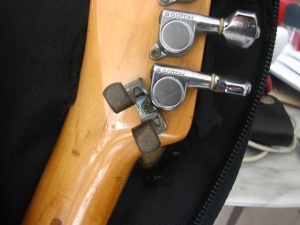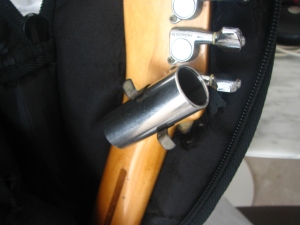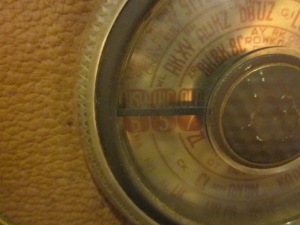Slide holder on guitar headstock
03/11/2013 Leave a comment
I’ve gotten a couple of queries on this so I figured it was worth a post.
I’m one of those that has to have lots of thingamajigs within easy reach during a gig. Tuners, slides, capos, picks, thumbpicks, spare strings, string winders, the whole works. There’s only so much space on a music stand or on top of an amp (unless you have the fortune of playing through a Fender Twin Reverb with a roadie to lug it around) so I had to figure a way to reduce my equipment footprint.
The tuner and capo clip on to the headstock and I’m not OCD about the appearance of my instrument being cluttered with stuff, so that’s not a problem with me. However, the slide was always a tricky one. Put it standing up anywhere and it risks being knocked over and rolling into an eternal abyss; leave it in your pocket and you’ll get some odd looks when you’re fumbling with what looks like your hands in your trousers in between songs.
So began the quest for a slide holder mounted on the guitar. A quick google search threw up a couple of options that mount conveniently behind the headstock where it’s easily accessible, but to this Cheapskate Engineer they were essentially just glorified versions of this:

It’s called a tool clip and you can get it at any decent hardware store (which is actually a bit harder to find than you might imagine, here in Singapore at least) and they’re probably a dollar for two or something like that. It already has the hole in the centre where you can screw it in, so here’s how I’ve mounted it on my Esquire:
The tool clip slots in underneath the Gotoh machine head screw boss and I’ve used the existing screw hole. The slide fits in nicely without obstructing my left hand at the first position. As long as your machine heads have a screw of some sort onto the headstock, this can be easily adapted. Now I can grab the slide mid-solo and let loose a fiery torrent of searing slide licks (or so I’d like to imagine), then clip it back on and keep chugging out chords with all four fingers.

































